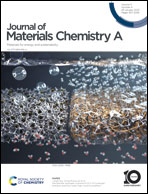Excellent room temperature catalytic activity for formaldehyde oxidation on a single-atom iron catalyst in a moist atmosphere†
Abstract
For human safety, efficient removal of formaldehyde in indoor environments is essential. However, removing formaldehyde from indoor environments given the low-temperature and moisture content remains a challenge. In this study, a metal–organic framework-based single-atom iron catalyst (FeSA) is proposed as a candidate catalyst for formaldehyde oxidation. The adsorption characteristic and the reaction path over FeSA with different coordination environments were explored using density functional theory (DFT) calculation. Guided by the theoretical results, FeSA with 5-nitrogen coordination (FeSA–N5–C) was selected and prepared for activity testing. The activity tests revealed that the removal efficiency of formaldehyde reached 85.8% at 25 °C and 75% relative humidity, which is far higher than currently reported data. More importantly, moisture can boost catalytic oxidation of formaldehyde through reduction of the energy barrier and activation of the O2 molecule, illustrating that FeSA–N5–C is robust enough for practical applications. We propose a new catalyst design route for removing formaldehyde from indoor environments, aiming for high low-temperature activity, strong water-resistance, and long-term stability.



 Please wait while we load your content...
Please wait while we load your content...